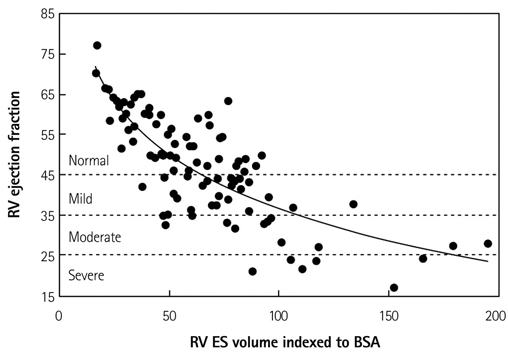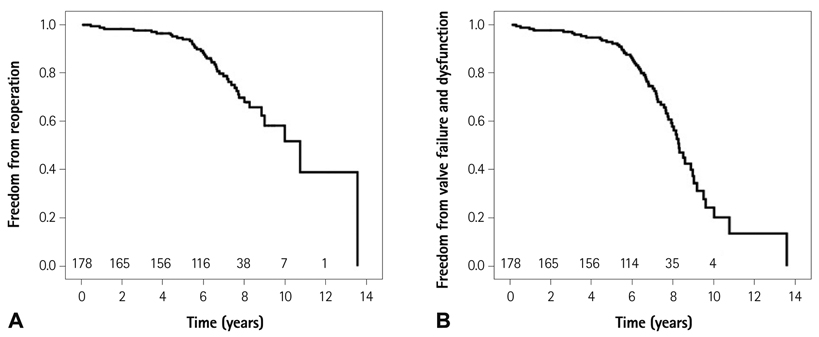Korean Circ J.
2012 Jan;42(1):1-7. 10.4070/kcj.2012.42.1.1.
Surgical Management of Chronic Pulmonary Regurgitation After Relief of Right Ventricular Outflow Tract Obstruction
- Affiliations
-
- 1Department of Thoracic and Cardiovascular Surgery, Cardiovascular Center, Sejong General Hospital, Bucheon, Korea. tscheul@hanmail.net
- KMID: 2297900
- DOI: http://doi.org/10.4070/kcj.2012.42.1.1
Abstract
- Relief of right ventricular (RV) outflow tract obstruction in tetralogy of Fallot or similar physiology often results in pulmonary regurgitation (PR). The resultant chronic volume overload can lead to RV dilatation, biventricular dysfunction, heart failure symptoms, arrhythmias and sudden death. Although pulmonary valve replacement (PVR) can lead to improvement in the functional class and a substantial decrease or normalization of RV volumes, the optimal timing of PVR is not well defined. Benefits of PVR have to be weighed against the risks of this procedure including subsequent reoperation. This article reviews the pathophysiology of chronic PR, evidence-based benefits and risks of PVR, options for valve substitute, and optimal timing of PVR in patients with chronic PR after relief of RV outflow tract obstruction.
MeSH Terms
Figure
Reference
-
1. Murphy JG, Gersh BJ, Mair DD, et al. Long-term outcome in patients surgical repair of tetralogy of Fallot. N Engl J Med. 1993. 329:593–599.2. Therrien J, Marx GR, Gatzoulis MA. Late problems in tetralogy of Fallot: recognition, management, and prevention. Cardiol Clin. 2002. 20:395–404.3. Gatzoulis MA, Balaji S, Webber SA, et al. Risk factors for arrhythmia and sudden cardiac death late after repair of tetralogy of Fallot: a multicentre study. Lancet. 2000. 356:975–981.4. Geva T, Sandweiss BM, Gauvreau K, Lock JE, Powell AJ. Factors associated with impaired clinical status in long-term survivors of tetralogy of Fallot repair evaluated by magnetic resonance imaging. J Am Coll Cardiol. 2004. 43:1068–1074.5. Bouzas B, Kilner PJ, Gatzoulis MA. Pulmonary regurgitation: not a benign lesion. Eur Heart J. 2005. 26:433–439.6. Cheung EW, Wong WH, Cheung YF. Meta-analysis of pulmonary valve replacement after operative repair of tetralogy of fallot. Am J Cardiol. 2010. 106:552–557.7. Geva T, Gauvreau K, Powell AJ, et al. Randomized trial of pulmonary valve replacement with and without right ventricular remodeling surgery. Circulation. 2010. 122:11 Suppl. S201–S208.8. Geva T. Repaired tetralogy of Fallot: the roles of cardiovascular magnetic resonance in evaluating pathophysiology and for pulmonary valve replacement decision support. J Cardiovasc Magn Reson. 2011. 13:9.9. Samyn MM, Powell AJ, Garg R, Sena L, Geva T. Range of ventricular dimensions and function by steady-state free precession cine MRI in repaired tetralogy of Fallot: right ventricular outflow tract patch vs. conduit repair. J Magn Reson Imaging. 2007. 26:934–940.10. Helbing WA, Niezen RA, Le Cessie S, van der Geest RJ, Ottenkamp J, de Roos A. Right ventricular diastolic function in children with pulmonary regurgitation after repair of tetralogy of Fallot: volumetric evaluation by magnetic resonance velocity mapping. J Am Coll Cardiol. 1996. 28:1827–1835.11. Helbing WA, de Roos A. Clinical applications of cardiac magnetic resonance imaging after repair of tetralogy of Fallot. Pediatr Cardiol. 2000. 21:70–79.12. Knauth AL, Gauvreau K, Powell AJ, et al. Ventricular size and function assessed by cardiac MRI predict major adverse clinical outcomes late after tetralogy of Fallot repair. Heart. 2008. 94:211–216.13. Sanchez-Quintana D, Anderson RH, Ho SY. Ventricular myoarchitecture in tetralogy of Fallot. Heart. 1996. 76:280–286.14. Davlouros PA, Kilner PJ, Hornung TS, et al. Right ventricular function in adults with repaired tetralogy of Fallot assessed with cardiovascular magnetic resonance imaging: detrimental role of right ventricular outflow aneurysms or akinesia and adverse right-to-left ventricular interaction. J Am Coll Cardiol. 2002. 40:2044–2052.15. Silka MJ, Hardy BG, Menashe VD, Morris CD. A population-based prospective evaluation of risk of sudden cardiac death after operation for common congenital heart defects. J Am Coll Cardiol. 1998. 32:245–251.16. Gatzoulis MA, Till JA, Somerville J, Redington AN. Mechanoelectrical interaction in tetralogy of Fallot: QRS prolongation relates to right ventricular size and predicts malignant ventricular arrhythmias and sudden death. Circulation. 1995. 92:231–237.17. Harrison DA, Harris L, Siu SC, et al. Sustained ventricular tachycardia in adult patients late after repair of tetralogy of Fallot. J Am Coll Cardiol. 1997. 30:1368–1373.18. Dave HH, Buechel ER, Dodge-Khatami A, et al. Early insertion of a pulmonary valve for chronic regurgitation helps restoration of ventricular dimensions. Ann Thorac Surg. 2005. 80:1615–1620.19. Oosterhof T, van Straten A, Vliegen HW, et al. Preoperative thresholds for pulmonary valve replacement in patients with corrected tetralogy of Fallot using cardiovascular magnetic resonance. Circulation. 2007. 116:545–551.20. Frigiola A, Tsang V, Bull C, et al. Biventricular response after pulmonary valve replacement for right ventricular outflow tract dysfunction: is age a predictor of outcome? Circulation. 2008. 118:14 Suppl. S182–S190.21. Lim C, Lee JY, Kim WH, et al. Early replacement of pulmonary valve after repair of tetralogy: is it really beneficial? Eur J Cardiothorac Surg. 2004. 25:728–734.22. Scherptong RW, Hazekamp MG, Mulder BJ, et al. Follow-up after pulmonary valve replacement in adults with tetralogy of Fallot: association between QRS duration and outcome. J Am Coll Cardiol. 2010. 56:1486–1492.23. Ghez O, Tsang VT, Frigiola A, et al. Right ventricular outflow tract reconstruction for pulmonary regurgitation after repair of tetralogy of Fallot: preliminary results. Eur J Cardiothorac Surg. 2007. 31:654–658.24. Therrien J, Provost Y, Merchant N, Williams W, Colman J, Webb G. Optimal timing for pulmonary valve replacement in adults after tetralogy of Fallot repair. Am J Cardiol. 2005. 95:779–782.25. Frigiola A, Giamberti A, Chessa M, et al. Right ventricular restoration during pulmonary valve implantation in adults with congenital heart disease. Eur J Cardiothorac Surg. 2006. 29:Suppl 1. S279–S285.26. Harrild DM, Berul CI, Cecchin F, et al. Pulmonary valve replacement in tetralogy of Fallot: impact on survival and ventricular tachycardia. Circulation. 2009. 119:445–451.27. Vliegen HW, van Straten A, de Roos A, et al. Magnetic resonance imaging to assess the hemodynamic effects of pulmonary valve replacement in adults late after repair of tetralogy of fallot. Circulation. 2002. 106:1703–1707.28. Therrien J, Siu SC, Harris L, et al. Impact of pulmonary valve replacement on arrhythmia propensity late after repair of tetralogy of Fallot. Circulation. 2001. 103:2489–2494.29. Doughan AR, McConnell ME, Lyle TA, Book WM. Effects of pulmonary valve replacement on QRS duration and right ventricular cavity size late after repair of right ventricular outflow tract obstruction. Am J Cardiol. 2005. 95:1511–1514.30. Gengsakul A, Harris L, Bradley TJ, et al. The impact of pulmonary valve replacement after tetralogy of Fallot repair: a matched comparison. Eur J Cardiothorac Surg. 2007. 32:462–468.31. Dos L, Dadashev A, Tanous D, et al. Pulmonary valve replacement in repaired tetralogy of Fallot: determinants of early postoperative adverse outcomes. J Thorac Cardiovasc Surg. 2009. 138:553–559.32. Borger MA, Ivanov J, Armstrong S, Christie-Hrybinsky D, Feindel CM, David TE. Twenty-year results of the Hancock II bioprosthesis. J Heart Valve Dis. 2006. 15:49–55.33. McClure RS, Narayanasamy N, Wiegerinck E, et al. Late outcomes for aortic valve replacement with the Carpentier-Edwards pericardial bioprosthesis: up to 17-year follow-up in 1,000 patients. Ann Thorac Surg. 2010. 89:1410–1416.34. Discigil B, Dearani JA, Puga FJ, et al. Late pulmonary valve replacement after repair of tetralogy of Fallot. J Thorac Cardiovasc Surg. 2001. 121:344–351.35. Caldarone CA, McCrindle BW, Van Arsdell GS, et al. Independent factors associated with longevity of prosthetic pulmonary valves and valved conduits. J Thorac Cardiovasc Surg. 2000. 120:1022–1030.36. Konakci KZ, Bohle B, Blumer R, et al. Alpha-Gal on bioprostheses: xenograft immune response in cardiac surgery. Eur J Clin Invest. 2005. 35:17–23.37. Manji RA, Zhu LF, Nijjar NK, et al. Glutaraldehyde-fixed bioprosthetic heart valve conduits calcify and fail from xenograft rejection. Circulation. 2006. 114:318–327.38. Park CS, Park SS, Choi SY, Yoon SH, Kim WH, Kim YJ. Anti alpha-gal immune response following porcine bioprosthesis implantation in children. J Heart Valve Dis. 2010. 19:124–130.39. Lee C, Park CS, Lee CH, et al. Durability of bioprosthetic valves in the pulmonary position: long-term follow-up of 181 implants in patients with congenital heart disease. J Thorac Cardiovasc Surg. 2011. 142:351–358.40. Fiore AC, Rodefeld M, Turrentine M, et al. Pulmonary valve replacement: a comparison of three biological valves. Ann Thorac Surg. 2008. 85:1712–1718.41. Kanter KR, Budde JM, Parks WJ, et al. One hundred pulmonary valve replacements in children after relief of right ventricular outflow tract obstruction. Ann Thorac Surg. 2002. 73:1801–1806.42. Allen BS, El-Zein C, Cuneo B, Cava JP, Barth MJ, Ilbawi MN. Pericardial tissue valves and Gore-Tex conduits as an alternative for right ventricular outflow tract replacement in children. Ann Thorac Surg. 2002. 74:771–777.43. Morales DL, Braud BE, DiBardino DJ, et al. Perimount bovine pericardial valve to restore pulmonary valve competence late after right ventricular outflow tract repair. Congenit Heart Dis. 2007. 2:115–120.44. Hawkins JA, Sower CT, Lambert LM, et al. Stentless porcine valves in the right ventricular outflow tract: improved durability? Eur J Cardiothorac Surg. 2009. 35:600–604.45. Kanter KR, Fyfe DA, Mahle WT, Forbess JM, Kirshbom PM. Results with the freestyle porcine aortic root for right ventricular outflow tract reconstruction in children. Ann Thorac Surg. 2003. 76:1889–1894.46. Yemets IM, Williams WG, Webb GD, et al. Pulmonary valve replacement late after repair of tetralogy of Fallot. Ann Thorac Surg. 1997. 64:526–530.47. Van de Woestijne PC, Mokhles MM, de Jong PL, Witsenburg M, Takkenberg JJ, Bogers AJ. Right ventricular outflow tract reconstruction with an allograft conduit in patients after tetralogy of Fallot correction: long-term follow-up. Ann Thorac Surg. 2011. 92:161–166.48. Oosterhof T, Meijboom FJ, Vliegen HW, et al. Long-term follow-up of homograft function after pulmonary valve replacement in patients with tetralogy of Fallot. Eur Heart J. 2006. 27:1478–1484.49. Rosti L, Murzi B, Colli AM, et al. Mechanical valves in the pulmonary position: a reappraisal. J Thorac Cardiovasc Surg. 1998. 115:1074–1079.50. Waterbolk TW, Hoendermis ES, den Hamer IJ, Ebels T. Pulmonary valve replacement with a mechanical prosthesis: promising results of 28 procedures in patients with congenital heart disease. Eur J Cardiothorac Surg. 2006. 30:28–32.51. Stulak JM, Dearani JA, Burkhart HM, et al. The increasing use of mechanical pulmonary valve replacement over a 40-year period. Ann Thorac Surg. 2010. 90:2009–2014.52. Quintessenza JA, Jacobs JP, Morell VO, Giroud JM, Boucek RJ. Initial experience with a bicuspid polytetrafluoroethylene pulmonary valve in 41 children and adults: a new option for right ventricular outflow tract reconstruction. Ann Thorac Surg. 2005. 79:924–931.53. Quintessenza JA. Polytetrafluoroethylene bicuspid pulmonary valve implantation. Oper Tech Thorac Cardiovasc Surg. 2009. 13:244–249.54. Brown JW, Ruzmetov M, Vijay P, Rodefeld MD, Turrentine MW. Right ventricular outflow tract reconstruction with a polytetrafluoroethylene monocusp valve: a twelve-year experience. J Thorac Cardiovasc Surg. 2007. 133:1336–1343.55. Quintessenza JA, Jacobs JP, Chai PJ, Morell VO, Lindberg H. Polytetrafluoroethylene bicuspid pulmonary valve implantation experience with 126 patients. World J Pediatr Congenit Heart Surg. 2010. 1:20–27.56. Warnes CA, Williams RG, Bashore TM, et al. ACC/AHA 2008 guidelines for the management of adults with congenital heart disease: executive summary: a report of the American College of Cardiology/American Heart Association Task Force on Practice Guidelines (writing committee to develop guidelines for the management of adults with congenital heart disease). Circulation. 2008. 118:2395–2451.57. Henkens IR, van Straten A, Schalij MJ, et al. Predicting outcome of pulmonary valve replacement in adult tetralogy of Fallot patients. Ann Thorac Surg. 2007. 83:907–911.
- Full Text Links
- Actions
-
Cited
- CITED
-
- Close
- Share
- Similar articles
-
- A Rare Case of Unruptured Sinus of Valsalva Aneurysm Obstructing the Right Ventricular Outflow Tract
- Biventricular Hypertrophic Cardiomyopathy with Severe Right Ventricular Outflow Track Obstruction
- A Case of Left Ventricular Outflow Tract Obstruction and Microangiopathic Hemolytic Anemia after Mitral Valve Repair
- Mitral Valve Replacement to Control Recurrent Systolic Anterior Motion of Mitral Valve and Left Ventricular Outflow Tract Obstruction after Alcohol Septal Ablation
- Concomitant Right Ventricular Outflow Tract Cryoablation during Pulmonary Valve Replacement in a Patient with Tetralogy of Fallot






